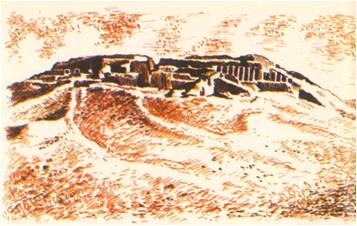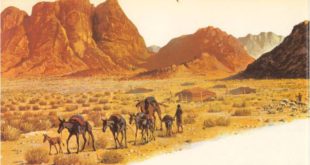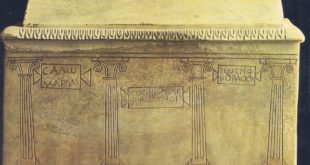For many generations, the ancestors of P’an Keng had considered themselves kings in northern China. Yet this family of kings, the Shang Dynasty, had never governed from a central capital. About 1380 B. C., P’an Keng decided it was time to set up a capital. He found what seemed to be the perfect site at Anyang. Situated near a bend in China’s Yellow River, the fertile plains were ideal for farming and pasture, while the mountains behind it had timber and wild game. Only one thing remained: P’an Keng had to find out if the move was approved by the gods and his ancestors.
P’an Keng sent for a diviner, one of the wise men who could read the will of the spirits. Everyone consulted the diviners for help in making decisions, whether it was the king planning a battle or a farmer wanting to know when to plant. Usually the diviner used animal bones in which small oval pits had been drilled. The diviner would heat a bronze rod in a fire and touch its point to the side of a pit. The heat cracked the bone slightly and by examining the size and angles of the cracks, the diviner interpreted the message of the spirits.
For special occasions in China, the diviner used a large piece of tortoise shell in place of bones and the choice of the capital was such an occasion. P’an Keng began to ask his questions, “should the capital be set up at Anyang?” “Was the dream a good sign?” “Does Shang Ti, the great god approve?” “Will Tang, founder of the Shang Dynasty, aid this move?” P’an Keng was overjoyed to hear the diviner interpret the answer to each question as “Yes” or “Fortunate”. This meant that the spirits approved.
Since this was such an important event in China, the questions and answers and even the date, were inscribed on the shell, which was then stored with the royal records. P’an Keng did not appreciate how wise this was until years later, when some of his people complained about the move to Anyang. Then P’an Keng was able to remind them that they should not oppose “the Great Tortoise” or the bones that determined men’s fate.
Anyang had been settled long before the Shang kings made it their capital. It had been one of many settlements that grew up during thousands of years throughout the vast area of China. The many mountain ranges, however, cut the early peoples from one another and each region developed in its own way.
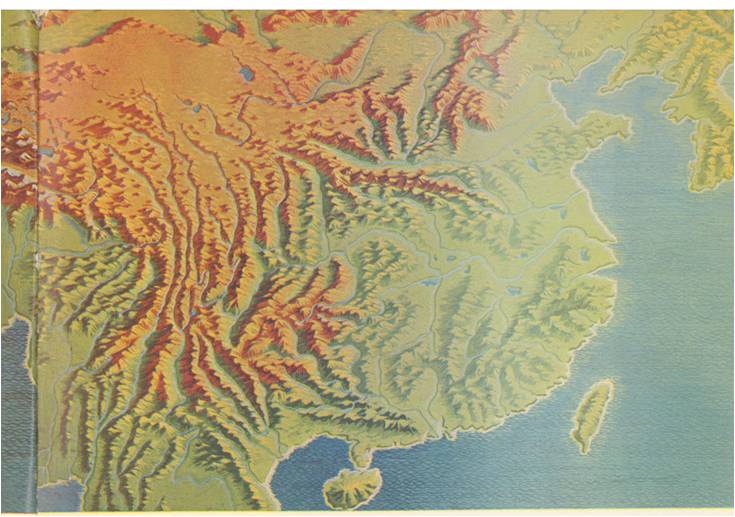
In the deserts, steppes and mountains that ringed China from west and north, nomadic tribes raised horses and sheep. Southward from the great Yangtze River, thickly wooded hills and a semi-tropical climate made it easier for men to live by hunting and fishing. Even after rice was introduced about 2000 B. C., many years passed before the people of south cultivated enough to support large communities.
The largest and the most important settlements in China were on the great plain and in the highland valleys of the northeast. The rich soil there was easy to cultivate; it held moisture and was free of rocks. Each year the river rushed out of the mountains to the north and west and overflowed onto the plain. As it twisted its way eastward to the sea, the river left behind masses of earth. Although the annual flood brought soil on which the people’s livelihood depended, it often wiped out dikes and villages and so the people called the Yellow River their “great sorrow,” even though they came to accept it and live with it.
Early Communities in China
The first Chinese farming communities began about 4000 B. C. Millet was their basic grain and pork their basic meat. Over the centuries, the people learned how to master the river somewhat, by draining and channeling; and as their harvests increased, their villages grew. By almost 2000 B. C., these people were building small huts of clay, often round and with thatched roofs. Inside they made clay ovens, cupboards and benches. They made pottery too and some of it was painted with handsome designs and within a few centuries, these people were casting bronze and writing down their language.
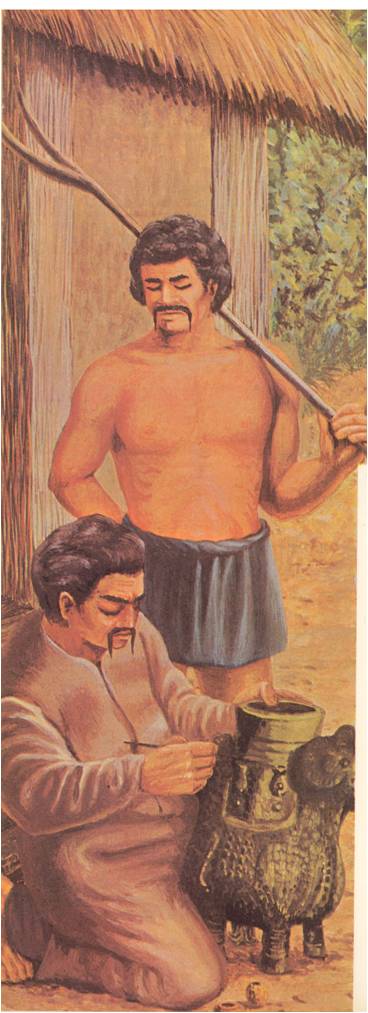
For some of their advances, the Chinese were originally indebted to people to the west – perhaps as far as the lands bordering the Mediterranean. During thousands of years, travellers and traders from the West and the East had met in the desert oases and mountain passes of central Asia. There they exchanged ideas as well as goods. Whatever the Chinese learned from other peoples, however, they quickly adapted and made their own, so that the Chinese of later centuries no longer knew they owed much to the peoples of the West.
Instead, the later Chinese made up stories about their own great kings who had introduced civilization to their ancestors. Starting about 2850 B. C., the legends went, these kings ruled for long periods, performing brave deeds, controlling the floods and inventing such things as fire and writing. The later Chinese would also tell about a whole dynasty of kings, the Hsia, who ruled before the Shang Dynasty and advanced Chinese culture.
Whoever the early kings were in China, they were little more than tribal chieftains. Even after T’ang the Victorious founded the Shang Dynasty, about 1500 B. C., the kings had no tightly organized state. There were continual battles and raids between the Shang kings and rival chieftains. When they won, the Shang Kings had no army to control any very large territory.
Under the Shang Dynasty, in fact, most people were farmers living in scattered villages. They kept cattle, sheep, dogs and they worked with wooden or stone tools. Their only concern was to assure the fertility of the land and the survival of their families. They had no idea of China as a nation. All that kept these people together was the fact that they spoke the same language and shared a basic way of life.
Only in a few towns were people beginning to develop a Chinese culture. The towns were citadels of the ruling class, the nobles and warriors and anyone with special skill or learning. The capital city Anyang, was specially grand and came to be known as “the giant city of Shang”. It had a mud wall and in the centre of the city was the king’s palace.
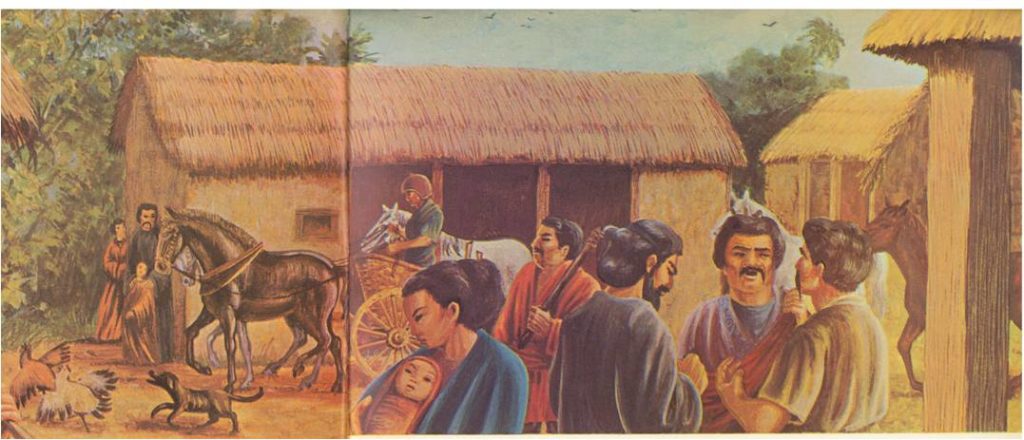
The Great City of Shang
The upper classes in Anyang lived far differently from the people of the country. They had wooden houses built on platforms of beaten earth. Some of them had begun to use horses and owned small weapons and ornaments made of bronze. Their clothes were made of linen and furs. A few of the very rich even had silk, for Shang people had already started what would later be China’s special industry.
A city like Anyang supported many craftsmen. Some carved fine statuettes from stone; some made beautiful pottery, even turning it on a wheel and firing it in a kiln. Perhaps the most respected craftsmen were those who made bronze vessels. Centuries before, some Chinese had leaned the methods of melting and casting metal from peoples far to the west. By 1100 B. C., the Shang bronze workers could make vessels of many shapes and sizes, as well as fine bronze bells. They did such expert and beautiful work that the objects they created could never be surpassed.
These bronze vessels were in great demand among the upper classes of late Shang times. Their religion involved frequent rituals and many of the ceremonies had to be performed with vessels of special shapes and designs. Foods and wines, for instance, had to be prepared and offered to the spirits in exactly the right vessel. This concern for doing things with elaborate precision was beginning to dominate the religion of the upper classes.
The king himself performed many of the ceremonies at court, while fathers presided at ceremonies within their own homes. The priests did little except assist at the ceremonies and consult the oracle bones. Among the poor and the peasants, the priests were more like magicians who could perform to assure fertility to the land. Although the lower classes did not have so many elaborate rituals, much of their religion also centred around the sacrificial ceremonies.
Sacrifices were made in temples and small chapels. The poor might offer only food, water and wine in simple clay pots, while the rich used fine bronze vessels and often sacrificed whole animals such as sheep, pigs or dogs. Some of the sacrifices were made to the gods present in every force and feature in the natural world. The earth, the wind, the rivers – all had their gods and over them all was Shang Ti, the great god, “The Ruler Above”. Shang Ti had a special influence over the battles and war, but he also gave good or bad fortune in such matters as raising crops.
Ancestor Worship in China
Shang Ti was a very real god to these people, but most of the other gods were only vague, impersonal forces. Artists did not even try to paint or carve figures of them. Far more important than the gods, especially to the upper classes, were the spirits of ancestors. After a man died, his spirit lived on and became the guide and protector of his descendants. The ancestor’s spirit lived with Shang Ti and had the power to give or withhold success, so the ancestors’ spirits were honoured and worshipped as gods.
The welfare of a family and indeed of the whole nation, depended on making proper sacrifices to the gods and spirits. Human beings were even sacrificed on special occasions, such as the time just after the king had died, about 1500 B. C. Several neighbouring regions were becoming rebellious and the Shang nobles feared that they had not made the proper sacrifices. This time they would leave no doubt about their respect for the gods and spirits.
As usual, the rulers would sacrifice several prisoners they had captured in battle and made slaves but perhaps this was not enough. The rulers then asked the diviners. “Shall we succeed in capturing barbarians from the west?” The oracle bone gave the answer – “Yes”. And so, while some men made preparations for the burial, warriors went off to raid for prisoners.
Outside of Anyang, the workmen dug another great pit in the burial ground of the kings and nobles. It was twelve yards on each side and about eight yards deep. At each end, ramps and stairs led to the bottom, where a smaller tomb chamber had been dug out. This chamber was lined with wood carved in fine reliefs, inlaid with boar’s tusk ivory and decorated in several colours of lacquer.
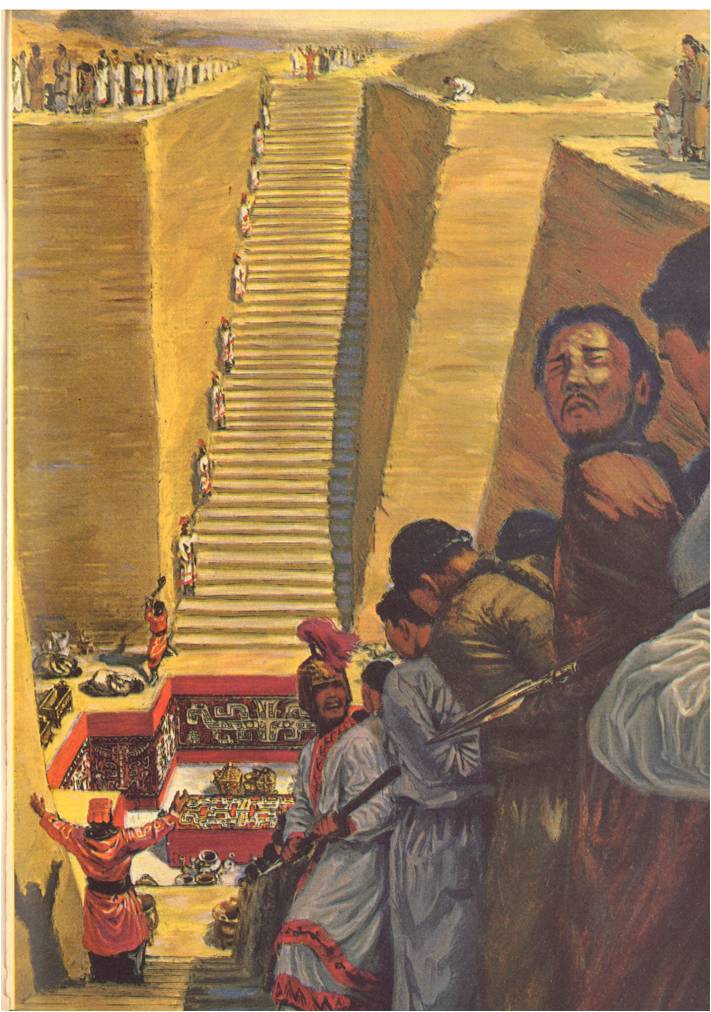
The body of the king was laid in this chamber, and around him were placed bronze vessels, weapons and royal treasures. Then, on various levels within the great pit, attendants and prisoners were sacrificed. Some were women wearing headdresses of turquoise; some were soldiers wearing helmets and weapons. Heroes and chariots were buried, too. As workmen filled in the pit with earth, still more victims were buried. By the time the ceremonies were finished, more that 200 people had been sacrificed.
Despite this great sacrifice, the Shang Dynasty was losing its power and not even the fine chariots of the kings and his nobles could save it. These chariots, ornamented with bronze, were of some advantage on raids or in battles, but they were mainly for ceremony and display. There were not enough chariot troops, either to fight off the restless border peoples such as the Chou to the west. The Chou moved into Shang territory and by about 1025 B. C., occupied Anyang, the capital. Proclaiming their king as “the Son of Heaven”, the Chou set up their own dynasty.
It was one thing to have a Chou king in the capital; it was another to go get people throughout a vast territory to accept his authority. In a series of campaigns, the Chou gained control over some cities and tribes. When necessary, they left one of their own people in command. For the most part, however, the Chou had to leave large regions under the control of the local princes. The most the Chou could hope for was that the local princes would take an oath of loyalty. In this way, the Chou kingdom became a feudal state.
At first, in the confusion that came with a new dynasty, there was a decline in the arts but the Shang culture had become firmly rooted in the Chinese people and they continued to make the fine bronze vessels. Religious practices remained much the same, too. The peasants, “the black-haired ones,” went on believing in the many gods in nature and they turned to the Wu, or magician priests, for aid in healing or magic spells. The upper classed and nobility still believed in the supreme god, whom they now called “Heaven” and still sacrificed to the spirits of their dead ancestors. The Chou also buried chariots in the great royal tombs. Unlike the Shang, however, the Chou did not sacrifice human beings.
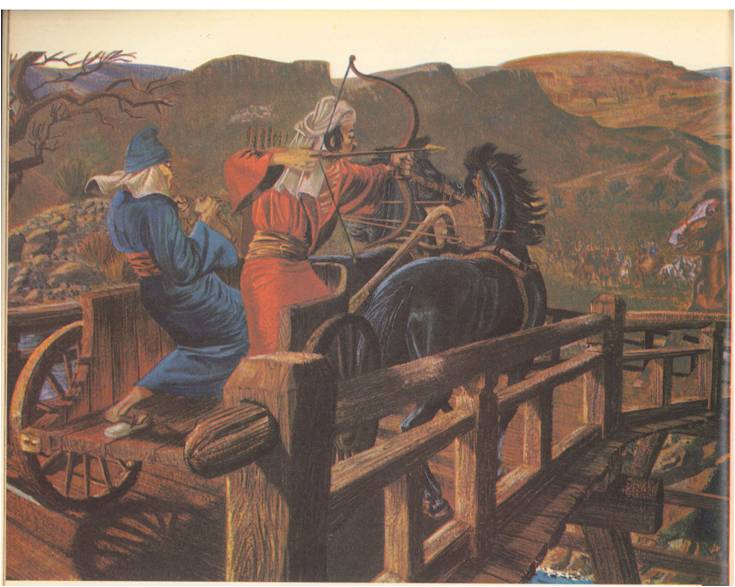
Although the Chou were rugged warriors, they could not hold their feudal kingdom together. By 770 B. C., an alliance of rebellious states took the Chou capital and the king was forced to settle at Loyang, a ceremonial city. Here the Son of Heaven was reduced to performing rituals and awarding honours to his various princes. He was a figurehead and the feudal chiefs now had the real power.
Worse was to come in the next few centuries as the whole feudal system collapsed among the warring chieftains. Border States and hill tribes, northerners and southerners, new and old leaders – all competed for power. Any chief who gained control used the Chou king as his puppet. One chieftain even claimed to be king while the Son of Heaven still reigned. With so much disorder in the country, it was not surprising that families fought against themselves.

Meanwhile a young man named Kung Fu-Tze, who later became known to the world as Confucius, was offering a new solution to the problem of governing China. He had been born about 550 B. C., in a small state of Lu, in the eastern province of Shantung. Although his father came of a good family, Confucius was poor as a youth and worked at various kinds of jobs. At the same time, he carefully observed his life around him and came to have his own ideas about what had gone wrong in Chinese society. He became convinced that the way to restore harmony was for men to learn how to conduct themselves properly.
Many people in his day believed in proper conduct or what they called Li. These people introduced Li in the narrow sense — the outward forms of ceremony or the strict rituals of sacrifice. Confucius was also in favour of proper ceremony, but he extended the idea to all men’s relationships and behaviour. Infact, it was better to miss some little detail in a ritual than to be discourteous to one’s fellow man. Confucius saw Li as the proper conduct on which the harmony of civilization depended. The ideals of Confucius were to be just, kind, loyal, sincere, unselfish — in a word, to be humane. Men of good birth and learning might find it easier than other people to live up to these ideals, but it was only through proper conduct that a person became a true aristocrat.
The Teachings of Confucius
Confucius held some minor position in government, but he was too independent and had to leave the service when he was about 35 years old. To support himself, he began to lecture to anyone who would come to listen. Most of his listeners were young men, who soon became his disciples. Some were the sons of nobles and were accustomed to paying well for private tutors. Others were poor and could contribute only a little package of dried meat, but Confucius welcomed them all. It was not that he believed there was anything especially good in being poor but poverty was nothing to be ashamed of as long as a man was trying to better his position in the world.
For Confucius wanted his disciples to remember that they were members of society. They must go out and live in the world, not retire from it. They were to be educated gentlemen, but they were to take an active part in reforming the government. The best government was one that brought about the harmony in which men could practice Li. Governments should never start a war, although people should fight if attacked but fighting would be necessary if all governments followed the rule Confucius preached to all men: never do anything to others that you would not want done to yourself.
Although Confucius wanted to reform the government, he was no revolutionary. He taught, instead, that men should keep what was best in the old ways. Above all, Confucius wanted to restore the old loyalty to the family.
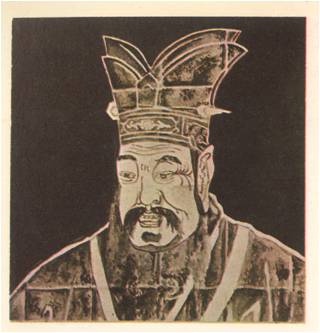
Confucius said little about the spirits of the ancestors or the gods, but he did not deny their existence. He accepted Heaven as a force in harmony with men who tried to live properly. For the most part, Confucius did not concern himself with religious questions. Once a pupil asked, “How should we serve the spirits?” Confucius answered, “You are not yet able to serve man. How can you serve spirits?”
Confucius attracted a number of followers, but during his lifetime he had influence on the nobles who ruled the country. There was one nobleman, however, who admired Confucius even though Confucius often criticized him sharply. The nobleman helped Confucius obtain an appointment to the Council of State, but when Confucius realized that he was expected to keep silent he resigned. Although he was now more than 50 years old, Confucius set out in search of some local ruler who would give him the opportunity to put his ideas into practice. For fourteen years he wandered from place to place, but in the end he had to give up his search. He returned to his birthplace, where he spent his last years, convinced that he was a failure.
Confucius died about 480 B. C., but his ideas did not die with him. During the next few centuries, when China was split by the warring feudal states, many learned men took up the search for the proper forms of conduct. Some of these men held positions of influence, while others wandered about, lecturing to whoever would listen. Many began as pupils or believers of the Confucian teachings, but as the years passed they began to differ with one another. Each claimed to have the only correct interpretations of Confucius and some even attacked his ideas. These teachers or their followers often collected their ideas in books and since each was anxious to prove that his ideas belonged to the mainstream of Chinese tradition, they often invented history. They made up stories of wise ancient kings, for instance, in the hope of showing that their own ideas could be traced to the past.
Conflicting Religions in China
Curiously, the same spirit of questioning was alive in many parts of the world at this time. From about 600 to 300 B. C., many exceptional men arose to challenge the beliefs of their people. In India, there was Mahavira, the founder of Jainism, as well as the great Buddha. In Iran there was Zoroaster. The Jews had prophets like Jeremiah and teachers like Ezra. In Greece there were Socrates, Plato and Aristotle. Some of these men were religious leaders, some were philosophers, some were teachers and some were reformers, but all, in one way or another, were seeking to define man’s goals.
In China alone there seemed to be a hundred different schools of philosophy competing for men’s minds. For instance, Mo Tzu, who was born about the time Confucius died, founded the school of Mohism. Mo Tzu felt that the Confucians put too much emphasis on proper conduct, such as the long periods of mourning for a dead member of the family. Mo Tzu wanted to extend the ideal of loyalty and love beyond the family to all people. Yet his idea of universal love was not emotional. He condemned everything emotional, including music. Mo Tzu believed in discipline and organized his followers like an army. For a while Mohism had some influence, but it was too cold and extreme a philosophy to attract many Chinese.
Among those who opposed Mohism was Meng Tzu, who later became known as Mencius. Like many others, Mencius insisted that he was presenting the correct version of Confucianism, but because there were now so many competing schools of thought, Mencius had to argue and defend his ideas much more than Confucius had done. Many of Mencius’s ideas were quite bold for his day. He claimed that man’s natural instinct was to do good, just as water naturally flowed downhill. He called kings murderers because their actions so often resulted in the death of their subjects.
Still another school of thought was that of the Taoists. They claimed to base their beliefs on the ideas of Lao Tze, “the old master”, although little was known about him. They took their name from the word Tao, meaning “Way.” They believed that men could pursue the true Tao, which was beyond senses, reason and actions. The Taoists encouraged men to draw from the world of affairs and to cultivate the natural, simple life. They rejected the idea that men should try to improve conditions on earth. Inner peace and happiness came before public duties.
The Taoists were in direct conflict with the Confucians, who believed that men could and should improve society. Confucians said that there should be no private satisfactions apart from public conduct. In time, Confucianism came to be accepted by the Chinese upper classes, though the appeal of Taoism always remained strong.
Neither Taoism nor Mohism nor Confucianism could save the Chou Dynasty, weakened by the centuries of struggle among its feudal states. In 256 B. C., the last Chou king gave up his throne to the feudal lords, the Ch’in rulers had prospered largely through trade. Their prime minister was a former merchant and it was his son Shih Huang who eventually seized power. By 222 B. C., Shih Huang and his supporters had gained control over the Chou kingdom and most of the former feudal states.
The Great Wall of China
Shih Huang set about to do what had never been done in China – to gather all the various states and provinces into a single Chinese empire. He encouraged the old feudal families to leave their own territories and to come to the capital. While their they felt flattered at being part of the court circle, but Shih Huang appointed his own officials to run the government. He was careful to divide up the power among many officials, so that no one man could become his rival. By such clever tactics, Shih Huang gained control over a vast territory.
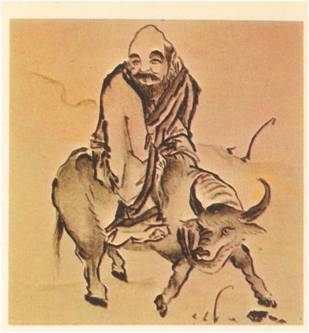
In doing so, he made himself responsible for defending the empire. There was little threat from the south, but in the north nomadic tribes had been raiding the Chinese farming villages for many years. Walls had been built here and there, but they were of little use against the swift-moving hordes. Shih Huang gave orders for a great wall to be built across the northern boundaries of his empire. The small walls were to be improved and enlarged and then joined in one continuous wall. Thousands of Chinese worked on this vast project and by 213 B. C. the Great Wall of China was completed. It extended for almost 2000 miles and had 25000 towers. Thousands of troops were stationed along its broad walks to keep guard.
Shih Huang and his supporters were not content with controlling of the empire. They wanted to force a unity on it. Standard weights and measures were adopted, as well as a standard width for wagon axles, so that the wheels would fit the tracks in any road. The official philosophy of the government was that of the Legalist school, which stressed discipline and efficiency. The ideal man was the hard-working, uneducated peasant, not the wandering scholar who raised doubts in people’s minds.
Shih Huang and his legalist advisers began to look upon all other schools of philosophy – especially that of the Confucians – as dangerous. In 213 B. C., the government collected all the books in the empire. Books on practical matters such as medicine was set aside and one copy of each of classic philosophy books was saved in the State Library. All the other books were burned. The State Library was later destroyed and scholars had to put together the classic books from what men could remember of them.
Although Shih Huang destroyed the books, he did help to reform the Chinese language. The Chinese spoke many dialects, some so different that they could not be understood by people from neighbouring regions of China. Moreover, in the 1,200 or so years the Chinese had been writing down their language, the signs had changed in various parts of China. Originally most of the signs were based on pictures of familiar things; each sign or combination of signs represented a word, but now all over China, the signs had developed different forms and were pronounced in different ways.
Shih Huang ordered that a uniform set of signs be adopted. Lists of correct words were issued, spelled in the basic script. All books, old or new, were to be written in this standard language. Shih Huang and his advisers changed the language because they wanted to make it more efficient, but the Chinese did not give up their idea that an individual’s handwriting could be as beautiful as a work of art.
As he carried out his ambitious program, Shih Huang began to think of himself as a great leader. He called himself “First Emperor”, convinced that there would be 10,000 to come in the empire he had created. The truth was that his chancellor and advisers had gained control of much of the power, while Shih Huang travelled about to be idolised by the people and for all his efficiency, he was as superstitious as everyone else.
The Threat of the Huns
On one of his trips, Shih Huang died. At once the empire was split by rivalries and rebellions, many of them led by people who resented the power that the imperial government had taken from them. In the end, the man who seized command was not from one of the old noble families. He was a rebel chieftain, Liu Chi, who entered the capital in 206 B. C. and declared himself emperor. Although he had still to defeat many other feudal lords, Liu Chi had established his own dynasty, the Han Dynasty.

Liu Chi had fought his way to the throne as an outlaw rebel and he had no intention of allowing the old feudal families to regain their power. Instead he put his followers in charge of the various states and regions. He tried to make his officials responsible to his imperial court, where he ruled along with his ministers, but many of the states and regions went their own ways, becoming almost independent kingdoms. For the next 400 years, the Han Dynasty was to be torn continually between those who wanted strong local government and those who wanted a strong central authority. Only the most forceful men could impose their policies on the whole empire.
Wu Ti, who came to the throne in 141 B. C., was such a man and he kept his power by leading the Chinese against their neighbours. In the north, for instance, there were the Hsiung-nu, or the Huns, nomadic tribes who had long been raiding the settled Chinese villagers. Even the Great Wall will not stop them and now they were threatening the trade routes and lands to the west. Wu Ti not only drove the Huns back, but he also gained control over much of the western territory. In addition, he absorbed many of the southern peoples. Through trade and gifts, Wu Ti held his vast empire together, but the people resented the heavy taxes to support his wars, his gifts and his court. When he died in 86 B. C., the emperor was once again reduced to being a figurehead.
Almost a century passed before another strong emperor came to power in China — the ambitious, clever Wang Mang. Although he was not in the direct line of succession, he forced the Han emperor to give up the throne to him. He invented a ceremony in which the imperial seal, a precious stone, was handed over to him, so that he appeared to be taking power legally.
Wang Mang pretended to be a progressive reformer and a friend of the people, but economic conditions soon became worse than ever. Finally there was an uprising led by the Red Eyebrows, a secret society of men who painted their eyebrows. Many groups joined in the rebellion and they captured the capital. Wang Mang refused to flee. He was sitting on his throne in his imperial robes when a soldier entered and cut off his head.
The Gentry in China
During the years of conflict in China, it often seemed as though China would collapse and perhaps it would have, were it not for the gentry, the people who owned the land and large estates. Some of the gentry were from old feudal and noble families, while others came from the new merchant class, but all shared the desire to keep order. Some of the gentry stayed on their estates to supervise the work and collect taxes, while other took positions with the imperial or provincial governments. The gentry could also afford to support some members of their families as educated scholars.
By intermarriage and co-operation, the gentry retained their privileges and influence, with some gentry families keeping power in their region for hundreds of years. Even when an examination system was set up to select officials, the gentry controlled it. They made up the tests and their sons were the best educated persons in China. Besides, the examinations were not designed to test who would be most capable or efficient in a job. The tests were to see who had the proper attitudes of the Confucian gentlemen.
The Growth of Culture
The teachings of Confucians were now accepted as the ideals of the upper classes, who were anxious to keep alive the traditions of the old aristocratic class. Confucian had said that the proper society would be run by humane, responsible men and the gentry saw themselves as just such men. Confucianism became there official code. The poor masses of Chinese, however, found little satisfaction in Confucianism; they needed something that would help them endure the hardships of their life on earth. They found it in Buddhism, the Indian faith which reached China by the end of the first century B. C.
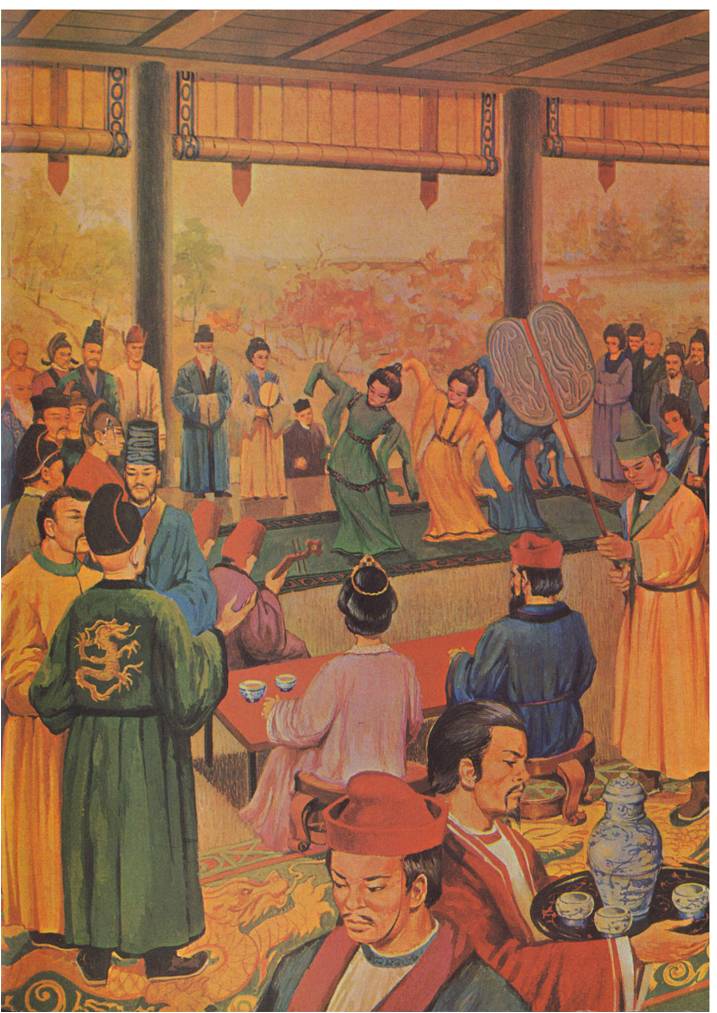
The gentry had no difficulty in accepting their life; it was a good one. They had fine homes and entertained their families and guests at banquets with acrobats and musicians. To visit friends or conduct affairs, they were rowed up and down the rivers and canals in sampan boats with little deck houses. In their leisure they gathered for poetry readings or painted for their own pleasure. They considered anyone who made his living by painting to be a mere craftsman.
No matter how the gentry looked down on them, the craftsmen of Han times kept up the Chinese traditions of artistic workmanship. The metal workers made elaborately decorated vases, bells and ornaments. The jade-carvers turned out delicate figures and designs. Certain Han craftsmen excelled in making lacquered objects, such as mirrors, toilet boxes and bowls. Before the Han period, artists had usually based their decorations on fantastic shapes and geometric forms. Now artists began to take an interest in natural forms. They began to depict animals and people in bronze and jade carvings, on tomb walls and on lacquer boxes.
Literature also flourished in Han times. At the imperial court, poets were encouraged to write in praise of the emperor. Singers and dancers from southern china introduced lovely poems and songs. Scholars copied and edited the Confucian texts and other classics with their newly invented ink and paper. Some texts were engraved on stone so that rubbings could be made and one standard version would circulate.
The gentry were anxious to learn and encyclopedias appeared in which everything known at the time was collected. The Book of the Mountains and Sea related animals, plants and myths to the geography of the known world. Shih Chi, the first history, was filled with everything from biographies to astronomy, music and economics. In their scientific writings, the Chinese did not show any special interest in searching for the basic laws of the natural world. Instead, they were more interested in practical inventions, just as their wise men had always been interested in improving society.
The Divided Empire
In spite of the high level of their culture, the Han people were unable to govern themselves. At the imperial court, various groups competed to gain influence over weak emperors. The land was split by warring lords and generals and the mass of people was forced to fight and pay taxes. About A. D. 184, a popular uprising was led by the Yellow Turbans, a religious sect. This was soon put down, but in its place came more feuding generals. By A. D. 220, the last Han emperor gave up the throne and China was divided into three kingdoms. What remained were the people – the scholars with their books, the gentry on their estates, the artists and craftsmen with their materials, the peasants in the fields. Only they would hold China together until the next great dynasties appeared.

